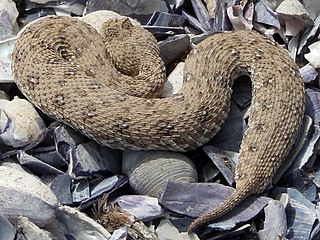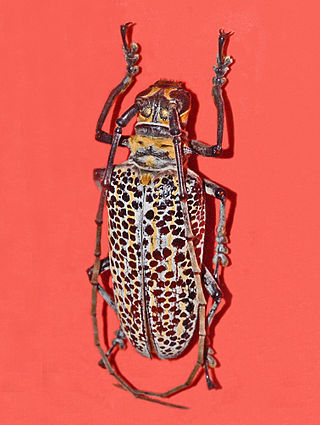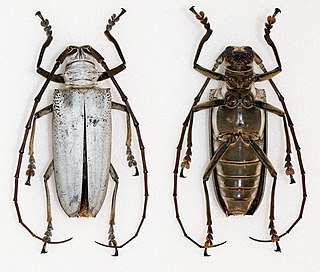
Eumeces schneiderii, commonly known as Schneider's skink, is a species of lizard in the family Scincidae. The species is endemic to Central Asia, Western Asia, and North Africa. There are five recognized subspecies.

The Boridae are a small family of tenebrionoid beetles with no vernacular common name, though recent authors have coined the name conifer bark beetles. The family contains three genera. Boros is native to North America and northern Eurasia, Lecontia is endemic to North America, while Synercticus is found in Australia and New Guinea. The larvae of Boros are found under bark and are especially associated with standing dead trees (snags), typically pines, found in old-growth forests. Lecontia larvae are found inhabiting damp parts of the root system of dead standing trees. Little is known of the life habits of Synercticus.

Bitis schneideri is a species of venomous snake in the subfamily Viperinae of the family Viperidae. The species is native to a small coastal region that straddles the border between Namibia and South Africa. B. schneideri is the smallest species in the genus Bitis and possibly the world's smallest viper. There are no subspecies that are currently recognized as being valid.
Elaeophora schneideri is a nematode which infests several mammalian hosts in North America. It is transmitted by horse-flies. Infection in the normal definitive hosts, mule deer or black-tailed deer, seldom produces clinical symptoms. In other hosts, such as sheep, elk, moose, and goats, infection with E. schneideri leads to elaeophorosis. Symptoms of elaeophorosis include necrosis of the muzzle, ears, and optic nerves; lack of coordination (ataxia); facial or lower limb dermatitis; horn deformities; blindness; and death.
Schneider's surprise is a species of nymphalid butterfly in the Danainae subfamily. It is monotypic within the genus Tiradelphe. It is endemic to the Solomon Islands.

Tetramorium inquilinum is an ectoparasitic ant found in Europe. It was discovered by Swiss myrmecologist Heinrich Kutter. The species is unusual for lacking a worker caste, the queens and males living entirely off the care of the pavement ant. It has been called "the 'ultimate' parasitic ant" by myrmecologists Edward O. Wilson and Bert Hölldobler.

Uatchitodon is an extinct genus of Late Triassic reptile known only from isolated teeth. Based on the structure of the teeth, Uatchitodon was probably a carnivorous archosauromorph. Folded grooves on the teeth indicate that the animal was likely venomous, with the grooves being channels for salivary venom. The teeth are similar to those of living venomous squamates such as Heloderma and venomous snakes. Uatchitodon is the earliest known venomous reptile.

Rosenbergia is a genus of longhorn beetles in the subfamily Lamiinae, close to the genus Batocera.

Rosenbergia rufolineata is a species of longhorn beetles in the subfamily Lamiinae.

Rosenbergia exigua is a longhorn beetle species found in New Guinea. It can grow to be up to 32 mm long. It was first described by Charles Joseph Gahan in 1888.

Stegodibelodon is an extinct genus primitive elephantid known from the Early Pliocene of Africa. It is known only from the Djourab region of northern Chad, where it was discovered in 1964 by the hydrogeologist Jean-Louis Schneider. It differs from the most primitive elephantid Stegotetrabelodon by the absence of lower tusks and a shortened mandibular symphysis, and the more pronounced nature of the lamellae on the molars, with each molar possessing at least seven lamellae, though the number of lamellae is low compared to modern elephant teeth, and the teeth are also low crowned (brachydont) relative to modern elephants.
The Diplocystidae are a family of parasitic alveolates in the phylum Apicomplexa.
Rosenbergia drouini is a species of beetle in the family Cerambycidae. It was described by Rigout in 1992. It is known from Australia.
Rosenbergia xenium is a species of beetle in the family Cerambycidae. It was described by Rigout in 1992. It is known from Papua New Guinea.
Rosenbergia freneyi is a species of beetle in the family Cerambycidae. It was described by Rigout in 1988.

Rosenbergia lactiflua is a species of beetle in the family Cerambycidae. It was described by Fairmaire in 1883. It is known from Papua New Guinea and Solomon Islands. It includes the varietas Rosenbergia lactiflua var. coerulescens.

Rosenbergia mandibularis is a species of beetle in the family Cerambycidae. It was described by Coenraad Ritsema in 1881.

Rosenbergia straussi is a species of beetle in the family Cerambycidae. It was described by Gestro in 1876.
Rosenbergia vetusta is a species of beetle in the family Cerambycidae. It was described by Coenraad Ritsema in 1881. It is known from Papua New Guinea.
Rosenbergia weiskei is a species of beetle in the family Cerambycidae. It was described by Heller in 1902.










